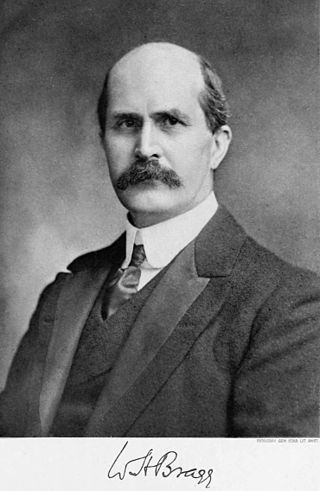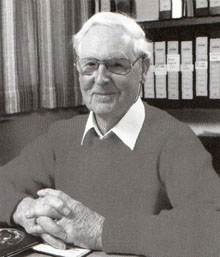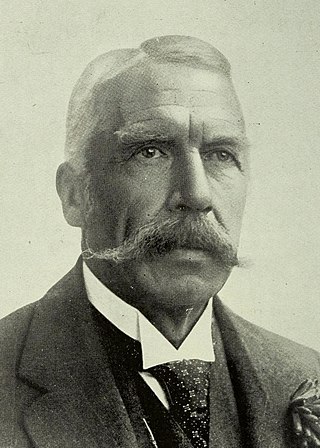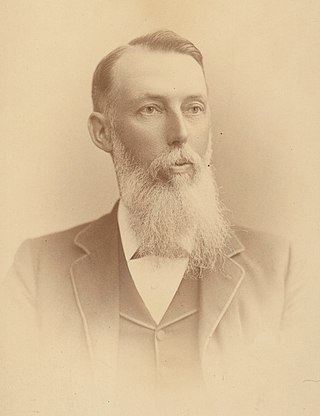Related Research Articles

Sir William Henry Bragg was an English physicist, chemist, mathematician, and active sportsman who uniquely shared a Nobel Prize with his son Lawrence Bragg – the 1915 Nobel Prize in Physics: "for their services in the analysis of crystal structure by means of X-rays". The mineral Braggite is named after him and his son. He was knighted in 1920.

The River Torrens is the most significant river of the Adelaide Plains. It was one of the main reasons for the siting of the city of Adelaide, capital of South Australia. It flows 85 kilometres (53 mi) from its source in the Adelaide Hills near Mount Pleasant, across the Adelaide Plains, past the city centre and empties into Gulf St Vincent between Henley Beach South and West Beach. The upper stretches of the river and the reservoirs in its watershed supply a significant part of the city's water supply.

Baron Sir Ferdinand Jacob Heinrich von Mueller, was a German-Australian physician, geographer, and most notably, a botanist. He was appointed government botanist for the then colony of Victoria, Australia by Governor Charles La Trobe in 1853, and later director of the Royal Botanic Gardens in Melbourne. He also founded the National Herbarium of Victoria. He named many Australian plants.

A cuesta is a hill or ridge with a gentle slope on one side, and a steep slope on the other. In geology, the term is more specifically applied to a ridge where a harder sedimentary rock overlies a softer layer, the whole being tilted somewhat from the horizontal. This results in a long and gentle backslope called a dip slope that conforms with the dip of resistant strata, called caprock. Where erosion has exposed the frontslope of this, a steep slope or escarpment occurs. The resulting terrain may be called scarpland.

Frank John Fenner was an Australian scientist with a distinguished career in the field of virology. His two greatest achievements are cited as overseeing the eradication of smallpox, and the attempted control of Australia's rabbit plague through the introduction of Myxoma virus.

Sir Charles Andrew Cotton was a New Zealand geologist and geomorphologist, described as one of the leading scientists that New Zealand has produced.

Sir Joseph Cooke Verco was an Australian physician and conchologist.
The Royal Society of South Australia (RSSA) is a learned society whose interest is in science, particularly, but not only, of South Australia. The major aim of the society is the promotion and diffusion of scientific knowledge, particularly in relation to natural sciences. The society was originally the Adelaide Philosophical Society, founded on 10 January 1853. The title "Royal" was granted by Queen Victoria in October 1880 and the society changed its name to its present name at this time. It was incorporated in 1883. It also operates under the banner Science South Australia.

The Australian and New Zealand Association for the Advancement of Science (ANZAAS) is an organisation that was founded in 1888 as the Australasian Association for the Advancement of Science to promote science.
William Noel Benson FRS FRGS was an English-born research geologist and academic active first in Australia and then New Zealand. After studying geology at the University of Sydney, Benson worked temporarily at the University of Adelaide before returning to Sydney as a demonstrator. After winning an 1851 Exhibition Science Scholarship in 1910 he left Sydney to study at the University of Cambridge, where he worked until 1913. He returned to Sydney in 1914 as the Macleay Fellow in Geology, leaving in 1917 to become Chair of the Geology Department at the University of Otago, where for many years he was the only lecturer. During his lifetime he published over 100 papers and won several awards, including the Clarke Medal and the Lyell Medal. He died on 20 August 1957 following his retirement from academia in 1951.

Sir Edward Charles Stirling was an Australian anthropologist and the first professor of physiology at the University of Adelaide.

Edward Henry Rennie was an Australian scientist and a president of the Royal Society of South Australia.
Professor Michael Archer AM, FAA, Dist FRSN is an Australian paleontologist specialising in Australian vertebrates. He is a professor at the School of Biological, Earth & Environmental Sciences, University of New South Wales. His previous appointments include Director of the Australian Museum 1999–2004 and Dean of Science at the University of New South Wales 2004–2009.

A bornhardt is a dome-shaped, steep-sided, bald rock outcropping at least 30 metres (100 ft) in height and several hundred metres in width. They are named after Wilhelm Bornhardt (1864–1946), a German geologist and explorer of German East Africa, who first described the feature.

Jane Visvader is a scientist specialising in breast cancer research who works for the Walter and Eliza Hall Institute in Melbourne, Australia. She is the joint head of the Breast Cancer Laboratory with Geoff Lindeman.
Michael J. Tyler dubbed "The Frog Man", was an Australian herpetologist and academic, noted for his research on frogs and toads, chiefly with the University of Adelaide.
The Wangkangurru, also written Wongkanguru and Wangkanguru, are an Aboriginal Australian people of the Simpson Desert area in the state of South Australia. They also refer to themselves as Nharla.

Trevor John McDougallFAGU is a physical oceanographer specialising in ocean mixing and the thermodynamics of seawater. He is Emeritus Scientia Professor of Ocean Physics in the School of Mathematics and Statistics at the University of New South Wales, Sydney, Australia, and is Past President of the International Association for the Physical Sciences of the Oceans (IAPSO) of the International Union of Geodesy and Geophysics.

The Humps is a granite rock formation known as a "stepped bornhardt inselberg". It is located within The Humps Nature Reserve approximately 295 kilometres (183 mi) east of Perth and 17 kilometres (11 mi) north east of Hyden in the eastern wheatbelt region of Western Australia.
The Reedbeds was in the 19th and early 20th centuries the generally recognised name for an area of seasonal freshwater wetlands to the west of Adelaide, South Australia comprising the floodplains of the River Torrens, and drained to Gulf St Vincent by the tidal estuaries of the Port River and the Patawalonga River. The ephemeral wetland was known as Witongga tarto to the indigenous Kaurna people. The area was also formerly known as the Cowandilla Plains. The wetlands were inundated annually by the winter flows of the River Torrens, and supported an abundance of wildlife, a valuable source of food for the Kaurna people during their summer camps along the coastal barrier dunes.
References
- ↑ "Charles Rowland Twidale". Encyclopedia Britannica.
- ↑ "Dr Rowl Twidale". adelaide.edu.au. University of Adelaide. 2 June 2017. Retrieved 9 June 2017.
- ↑ "About the Society". Royal Society of South Australia. Archived from the original on 15 March 2015. Retrieved 24 June 2017.
- ↑ ANZAAS > Mueller Medal Recipients archive.is Retrieved 9 July 2017,